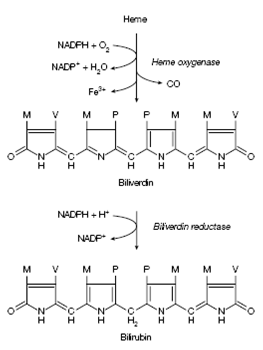Heme degradation:
Bile pigments exist in both the animal and plant kingdoms, and are building through breakdown of the cyclic tetrapyrrole structure of heme. In the animals this pathway is an excretory system through that the heme from the hemoglobin of aging red blood cells, and other hemoproteins, is erased from the body. In the plant kingdom, moreover, heme is broken down to form bile pigments that have main roles to play in coordinating light responses in higher plants (the phycobiliprotein phytochrome), and in light harvesting in algae (the phycobiliproteins phycoerythrin and phycocyanin).
In all organisms, the degradation of heme starts with a reaction carried out through a single general enzyme. This enzyme, heme oxygenase, is present mainly in the spleen and liver of vertebrates, and carries out the oxidative ring opening of heme to produce the green bile pigment biliverdin and a linear tetrapyrrole. The Heme oxygenase is a member of the cytochrome P450 family of enzymes and needs O2 and NADPH. In birds, reptiles and amphibians this water- soluble pigment is the last product of heme degradation and is excreted directly. In mammals, thus, an additional conversion to the red-orange bilirubin takes place; a reaction catalyzed through biliverdin reductase. The changing color of a bruise is a visible indicator of these degradative reactions. The bilirubin, like other lipophilic molecules like as free fatty acids, is then send in the blood bound to serum albumin. In the liver its water solubility is

Figure: Degradation of heme to the bile pigments biliverdin and bilirubin. M methyl (CH3), V vinyl (CH CH2), P propionyl (CH2CH2CH2OH).
increased through conjugation to two molecules of glucuronic acid, a sugar residue which differs from glucose in having a COO- group at C-6 rather than a CH2OH group. The conclusion bilirubin diglucuronide is secreted into the bile and then into the intestine, where it is further metabolized through bacterial enzymes and at last excreted in the feces.
When the blood holds excessive amounts of the insoluble bilirubin and it is deposited in the skin and the whites of the eyes and resulting in a yellow discoloration. This situation, known as jaundice it is indicative either of impaired liver function and obstruction of the bile duct or excessive breakdown of erythrocytes.